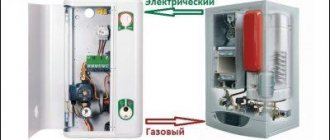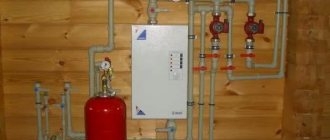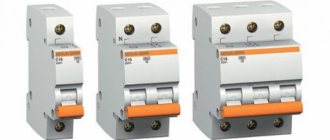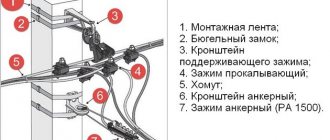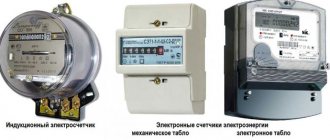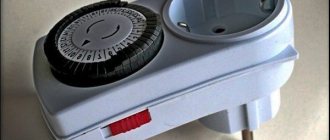It is impossible to imagine a house or apartment without electrical appliances, unless you are a hermit and have chosen the taiga as your place of residence. We are so accustomed to the comfortable living provided by a variety of devices that we simply cannot imagine life without them. And we are very upset if something suddenly breaks down or if we initially bought a very low-quality product.
Even if your house is not filled with appliances and gadgets, and does not have the functions of a “smart” home, then there are definitely sockets and switches.
No. 1. Advantages and disadvantages
An electric heating boiler works extremely simply. In it, electrical energy is converted into thermal energy. When the boiler is turned on, the heating elements heat the coolant. The latter enters the living space through a system of pipes and radiators and heats the air in it. In the simplest and most common version, the usual heating element is used as a heating element, but there are also induction and electrode boilers in which heating is carried out somewhat differently. The only thing that remains unchanged is the power source – electricity. Many boiler models are equipped with a monitoring and control mechanism.
Despite the fact that electric boilers can hardly be called an economical source of heat, they are very popular, and there are many reasons for this. The advantages of electric heating boilers include:
- versatility. The unit can be installed wherever there is electricity ; no permits from technical supervision authorities are needed. Today, electric boilers are used both in private homes and apartments, as well as in commercial and industrial premises;
- low cost compared to gas and solid fuel boilers;
- high efficiency , which reaches 95-99%;
- ease of installation. Electric boilers are small in size , and when connecting them there is no need to build a chimney;
- ease of operation and temperature adjustment. Most models are equipped with convenient control systems and thermostats, so the user just has to press a few buttons or turn a lever - he won’t have to constantly run to the boiler, control its operation, or, worse, add fuel. Since the boiler perfectly controls its operation, its efficiency increases;
- safety . There is no open fire in electric boilers, and no flammable fuel is used. Plus, well-thought-out automation is used, so the likelihood of emergency situations compared to other types of boilers is sharply reduced, if, of course, the installation was carried out correctly;
- compactness, so installation of such a unit is possible even in the smallest rooms;
- environmental friendliness, because no harmful emissions are generated during boiler operation;
- noiselessness;
- no need for constant monitoring of operation (you can leave the boiler unattended) and frequent maintenance. Solid fuel boilers, for example, require constant care and cleaning;
- a wide range of. There are models on the market with different power (from 2 to 60 kW or more) and functionality (single-circuit and double-circuit).
disadvantages :
- high cost of operation. Despite advanced automation and energy saving systems, electric boilers are still quite expensive to operate. In most cases, it is not profitable to use them for heating large rooms. Often such boilers are used as a backup heat source ;
- dependence on the availability of electricity. If the region experiences frequent power outages, then this heating option is not suitable;
- the need for special three-phase wiring if a boiler with a power of more than 12 kW is used. Some experts recommend using a line with three phases even when connecting a boiler from 6-7 kW.
Despite the existing disadvantages, electric boilers find their buyers. Moreover, if you carefully analyze the conditions at the site where you want to create a heating system and choose the right electric boiler, you will be able to enjoy the positive qualities of these devices to the maximum.
What to choose: comparison of consumption, cost, ease of use
If we focus on ease of installation, ease of operation, and average price, then the first place in the ranking is occupied by boilers with heating elements. As a standard, they are carried out in a monoblock case that is completely ready for operation after installation - it already has a safety group, an expansion tank, a circulation pump and other elements. You just need to connect it to the input and output of the heating system. But they are in last place in terms of economy and cannot be called energy-saving.
If we consider the question of which electric boiler is the most economical and with the best energy saving, then we should consider induction and ion units.
Vortex heaters are in first place in terms of economy, but they have a number of disadvantages that slightly offset this advantage: price, difficulty in repair, large dimensions. These are the most expensive and inconvenient electric boilers considered: the cost of such a 25 kW product is 86 thousand rubles. (A new heating element for 24 kW can be bought for 46 thousand).
Below is a table comparing different types of electric boilers. But the data in it should not be unconditionally trusted - manufacturers are trying to show their products in a favorable light. For example, in other sources, ion boilers are shown to be much more economical and efficient than heating element boilers.
| heating elementnew | Electrode | Induction | |
| Efficiency | 98 % | 94 % | 99 % |
| Loss of power after 12 months of use | 20 % | 15 % | 0 % |
| Maximum pressure | 3 atm | 3 atm | 6 atm |
| Heating temperature | Up to 90 degrees | Up to 85 degrees | Up to 115 degrees |
| Life time | 3–7 years | 10–12 years | 30–60 years |
| Probability of failure within 12 months | 15–20 % | 15–35 % | 0 % |
Another disadvantage of SAV and VIN is the large dimensions of the housing itself and the individual elements that include the control cabinet. A product with a tubular electric heater contains everything you need in a compact case, and an ion boiler generally resembles a thick water pipe. The weight of a 25 kW induction boiler is 80 kg, a heating element of the same power is 40 kg.
Vortex boilers are increasingly being chosen for private homes. Although such devices are the most energy-saving, they are more often used in places where induction heating is indispensable - in industrial, production environments, and chemical plants.
Economics of VIN use
| The name of a room | Heated area/volume | VIN model | power, kWt | Cost kW/h, rub. | Monthly payment, rub./month. | Payment for the heating period, rub. |
| 1 room apartment | 50 m² | VIN-3 | 3 | 2.0 | 1227.6 | 9147.6 |
| House | 100 m² | VIN-7 | 7 | 2.2 | 2864.4 | 21334.4 |
| Garage box | 450 m³ | VIN-10 | 10 | 3.2 | 5952 | 45888 |
| Hangar | 1000 m³ | VIN-20 | 20 | 3.2 | 11904 | 91776 |
Ion (electrode) boilers are the best choice in the economy class in all respects, especially in terms of cost, if you need an energy-saving heater for heating a private home. Their economy and efficiency may be somewhat lower than that of induction and heating elements products, but this is compensated by ease of maintenance and small size. An important fact in favor of ion boilers is the price - these are the cheapest energy-saving heaters for heating (4-5 thousand rubles).
Ion boilers are a good option as an additional heating source. If you use them as main devices, you can embed several of these cylinders for greater efficiency.
No. 2. Types of electric boilers by type of heating element
Depending on how the water is heated, all boilers are divided into heating elements, electrode and induction.
Heating elements new boilers
This is the most popular version , and so popular that when talking about electric boilers, as a rule, they mean designs with heating elements. This unit works on the principle of a boiler. Electricity is supplied to a tubular electric heater (TEH), it heats up and transfers heat to water, which is used as a coolant. The heating element consists of a nichrome spiral and a durable shell made of steel, aluminum or titanium. The space between the spiral and the shell is filled with quartz sand or other dielectric filler.
The rated power in such boilers is achieved abruptly, approximately 10-15 minutes after switching on. Heating element boilers operate in flow mode and can be single-circuit or double-circuit. As a rule, several heating elements are placed in the boiler tank.
Since there is no direct contact of the heating coil with water (the dielectric plays the role of a separator), there is no need to be afraid of a short circuit. The main problem of such boilers is different. scale appears on it relatively quickly , which can gradually damage the boiler. To slow down this process or even avoid it completely, it is better to use distilled water in the system. Special liquids are also sometimes used. The boilers are protected from overheating of the coolant by a thermal regulator, but if a leak occurs, the unit risks overheating and failure.
Electrode (ion) boilers
The design of this boiler involves the presence of two electrodes immersed in a heat exchanger. Electrical energy is supplied to them, due to which a potential difference is created. Due to the presence of salts in the coolant, it turns into a current conductor. Electricity passing through the high resistance electrolyte causes it to heat up. Just a couple of minutes is enough for the boiler to reach its rated power. Specially prepared water or ethylene glycol-based liquid is used as an electrolyte (coolant)
Boilers of this type are quite economical , and to provide the same thermal power as a heating element boiler, they consume almost half as much electricity. Such units, as a rule, have reliable, well-thought-out automation and rarely fail, since, in fact, there is nothing to break here. If a leak occurs in the system, overheating will not occur - there is no electrolyte. Electrode boilers also perform well under unstable voltage conditions. If it drops down to 180 V, the unit will continue to operate and produce heat.
The only downsides are the cost of the equipment and the need to use specially prepared coolant. Its composition will determine how much energy the boiler will spend on heating. Another nuance is the need for reliable grounding. The electrodes will have to be changed periodically.
Induction boiler
Boilers of this type began to be used back in the 80s of the last century, but at first they were installed only in production. The production of household models began only towards the end of the 90s. Their operating principle is quite complex and resembles a transformer. The heart of the unit is an induction coil, which converts electrical energy into a magnetic field, directing it to the core. The latter is a system of steel pipes with coolant inside.
The system performed well. Induction boilers are economical and very compact , durable (service life 30 years or more) and fireproof, and the problem of scale is not a problem with them. There are no strict requirements for the coolant, as in the two previous types of boilers - even purified petroleum products can be filled.
The main disadvantage is the high price . In addition, induction boilers weigh decently, despite their miniature dimensions. You won’t be able to find a model lighter than 20 kg.
Which boiler is better to choose depends on your budget and your requirements - all three types can be found on sale.
Heating options
If it is possible to connect to the gas mains, we recommend choosing a gas boiler without hesitation, even despite the complex process of its registration. Otherwise, from an economic point of view, electric heating boilers are not always justified.
Electric boilers are compact in size, require a minimum of wiring and have a modern design, which allows them to be installed anywhere.
The most financially profitable option is to temporarily use an electric boiler. For example, at a dacha or in a second country house, where the owners come only from time to time, but do not live permanently. In such cases, the 1.5-3 times lower initial cost of the boiler, its installation and connection will cover the cost of electricity during operation for a long time.
Since all electric boilers (with the exception of induction) are designed to use exclusively water as a coolant, which freezes at subzero temperatures, it would be desirable in such a situation for the boiler to have the ability to connect external control. For example, using a GSM module or Wi-Fi module. Firstly, this will allow you to control the electric boiler remotely and set the desired temperature before arriving at the house. Secondly, remote control will give you confidence that in the absence of the owners the boiler maintains a positive temperature and the system is not damaged (otherwise you will immediately receive a notification).
Another great option is to use an electric boiler as an additional or backup heating equipment. For example, in a scheme using a buffer tank in case of problems with the operation of the main boiler and heating at a night tariff, or for a heated floor circuit. For such purposes, an inexpensive 3-6 kW electric boiler costing 11-15 thousand rubles, operating from a single-phase power supply, is quite sufficient. It will be able to maintain temperatures above +18°C in a house of about 100 square meters. m. for 2-2.5 days or completely ensure the normal temperature of the heated floor on an ongoing basis.
A simple and compact low-power model EVAN EPO.
Water-heating electric boilers can be used as the main heating equipment only if you have a free budget. The only exceptions are small and insulated houses with an area of up to 90-100 m2. To heat such an area, taking into account medium or dense insulation, an inexpensive electric boiler with a capacity of 6-9 kW will be sufficient. The low cost of the boiler unit and its installation, as well as the absence of the need for its coordination with Energonadzor services, will pay off the high operating costs for another 1-3 heating seasons.
No. 3. Connection type
Before purchasing a boiler of a certain power, you need to find out the features of the electrical wiring in the house. Among boilers with a power of up to 10-12 kW, you can find models that can be connected to both single-phase (220 V) and three-phase networks (380 V). It will not be possible to use more powerful boilers with a single-phase network - you will need to connect the house to a three-phase network.
To connect the boiler to the panel, it is better to use a stranded copper wire, which, with higher conductivity, will heat up less.
No. 4. Number of circuits
Among electric boilers, single-circuit models . They are only responsible for the heating system. To provide yourself with hot water supply, you need to retrofit the system with a water heater or take a double-circuit boiler . The latter has two independent circuits for heating water. Double-circuit electric boilers consume a lot of electricity, so they are used quite rarely.
conclusions
- We recommend choosing an electric boiler from the heating element or electrode type.
- To make the final decision, calculate the required boiler power, taking into account a small margin (+ 10-20%). If you purchase a double-circuit boiler, the calculated power should be at least a quarter greater.
- Imported equipment is much more expensive, but has no fundamental advantages. Inexpensive domestic boilers, cheap to repair and maintain, are not inferior in efficiency to imported models.
No. 5. Electric boiler power calculation
The power of electric boilers ranges from 2 to 60 kW (for industrial and commercial premises there are even 400 kW models) and is selected depending on the size of the room to be heated and whether there is a need to heat water for hot water supply. Ideally, to determine power, it is necessary to carry out a full thermal calculation, taking into account not only the area of the room, but also the height of the ceilings, the level of thermal insulation, the number of windows, doors and other factors. To do this, it is better to turn to professionals, but calculate the approximate power yourself.
The easiest way is to use the proportion according to which it is necessary to provide 1 kW of boiler power for every 10 m2 of area, provided there is sufficient thermal insulation and with a ceiling height of no more than 3 m. It is better to add a little more reserve (10-15%), and if you use a double-circuit boiler, then add another 25% to the resulting value. This calculation is quite conditional, and to obtain more accurate results you can use another, slightly more complex, formula.
The power of an electric boiler can be calculated as follows:
- W = (40*S*h+Qo +Qd )*k , where
- 40 – average required boiler power per 1 m3, 40 W/m3;
- S – area of the house/apartment;
- h – ceiling height;
- Qо – heat loss through windows, 100 W for each;
- Qd – heat loss through doors, 200 W for each;
- k is a coefficient that depends on the region; for the southern regions of the country it can be taken as 0.7-0.9, for the central and European parts - 1.2-1.4, for the north and far east - 1.8-2.0.
If the calculation is carried out for a private house , the result obtained is multiplied by another 1.5.
Let's say there is a house with an area of 85 m2, a ceiling height of 2.8 m, with 6 windows and 2 doors, it is located in the southern part of the country. The required power will be equal to W=(40*85*2.8+600+400)*0.8*1.5=12.6 kW.
Guidelines and what to consider when choosing an economical electric heating boiler
An economical electric boiler must have programmable operation, the ability to connect a rheostat for on/off. during periods of low tariffs or when a certain temperature is reached, as well as to regulate heating. At a minimum there should be at least a three-stage power switch.
The ideal option is if the device has smooth adjustment and factory economy modes. The product must be suitable for connection to room rheostats, which have many fine settings and respond to the air temperature in the room.
Single- and double-circuit electric boilers
If you need to provide hot water at the same time as heating, then choose double-circuit electric boilers. Moreover, the electricity consumption in such products is practically no different from single-circuit ones. DHW water is heated by washing the heat exchanger in the heating boiler circuit, without mixing with its coolant. Such heating does not require additional power, although for greater efficiency there are models with increased energy consumption.
No. 6. Power regulation and boiler control system
In electric boilers, it is enough to simply regulate the power and temperature of the coolant. Actually, these two parameters are interrelated, so it is impossible to consider them separately from each other.
The boiler power is adjusted in one of the following ways:
- stepwise - a common option in heating element boilers. In this case, the design provides one heating element, which provides half the power, and two, which provide 25% heating each. It turns out that the boiler can operate at 25, 50, 75 and 100% of the maximum power; more precise adjustment can be made in each room thanks to the valves on the radiators;
- Smooth adjustment is achieved through the use of a rheostat. This is a privilege of more expensive models. In simple low-power boilers there may be no adjustment at all.
The user sets the boiler the required coolant temperature to maintain comfortable conditions in the house, and the boiler turns on the heating and turns it off when the coolant is sufficiently hot. Automation can work using mechanical and electronic thermostats. Both options allow you to save energy and maintain a comfortable temperature without constantly monitoring the boiler.
A mechanical thermostat cuts off the coolant flow or opens the electrical network when the user-specified coolant temperature is reached. When the temperature drops, the boiler turns on again. This is a simple and cheap method, but not the most accurate - the coolant temperature at the boiler outlet may differ by 2-30C from the set one. Electronic thermostats are more accurate; they consist of a remote sensor and a control unit. The sensor is attached to the heating element and transmits information about its temperature to the unit remotely or using wires. Naturally, such boilers are more expensive.
How does an electric boiler work?
In order to choose the right electric boiler for heating your home, you need to know its characteristics and make sure that they meet the network requirements. Any electric heating boiler for a home includes the following elements:
- Frame. The outer shell, inside which all the boiler parts are assembled;
- Heat exchanger. Heater and container with coolant;
- Control block. Process control, monitoring and regulation system.
Diagram of an electric boiler with a heating element
No. 7. type of instalation
Electric boilers can be:
- wall-mounted;
- floor-mounted
It is clear that wall-mounted ones take up less space and are suitable in cases where space is very limited. Western manufacturers prefer this installation format. In floor-standing versions, as a rule, more powerful boilers are produced, which need to heat a large volume of coolant.
No. 8. The best manufacturers of electric boilers
There are dozens of manufacturers, both foreign and domestic, on the electric boiler market. European boilers usually have smooth adjustment and are assembled from more expensive components. Our boilers mainly have step adjustment, which is why they are cheaper. Probably, each of us understands well that it is better not to save on the heating system, so you should not trust little-known companies. The largest , proven and reliable manufacturers of electric boilers in the world and Russia:
- Protherm is a Czech manufacturer that started with the production of electric boilers. Today, other types of heating boilers are produced, as well as boilers, thermostats, etc. The company's electric boilers are wall-mounted, power from 6 to 28 kW, efficiency 99.5%, and are available in a single-circuit version. In 2001, the company became part of the German Vaillant group of companies;
- Vaillant produces slightly more expensive boilers than Protherm, power up to 28 kW, all models are easy to use and reliable;
- Buderus is a large German company that produces electric boilers for private homes and commercial properties, the power of wall-mounted single-circuit models is 30-60 kW;
- Kospel are reliable Polish electric boilers, available in a wide range. Power from 4 to 36 kW, models up to 8 kW are presented in two versions, for working with a network of 220 V and 380 V;
- Bosch also produces electric boilers, power from 4 to 24 kW, wall-mounted, with one circuit, but it is possible to connect an indirect heating boiler. You can buy either a simple boiler or a boiler complete with an expansion tank and pump;
- Ferroli are high-quality Italian electric boilers with a power from 6 to 28 kW with very well-thought-out automation and a wide range of additional functions. The boilers have connectors for connecting room and street temperature sensors, a large display, the ability to daily program the operation of the boiler and even control the boiler using the remote control;
- ZOTA are domestic boilers that are distinguished by the most affordable price and fairly high-quality performance. Power from 3 to 400 kW, boilers are presented in several lines, heating elements are used as heaters;
- RusNIT - good budget boilers from a Ryazan company, power from 3 to 99 kW;
- Evan is a large domestic manufacturer, part of the NIBE concern, producing boilers in different price segments. Power from 2.5 to 480 kW.
It is also worth noting the products of the companies Dakon, ACV and RECO, Intois, Alvin, Resurs.
What dangers do faulty electrical appliances pose?
Electrical products are not the case when you need to save a lot, because faulty products can cause many problems:
- quick breakdown, and this is not the worst thing, although it is unpleasant;
- power surges, burnout of electrical plugs, which can lead to the failure of other devices;
- short circuit, which can lead to the most dire consequences, i.e. to the fire.
Considering all of the above, buy only high-quality products from manufacturers that have proven themselves in the market.
Next, we will give advice on choosing the most necessary electrical appliances, which are very difficult to do without in our time.
